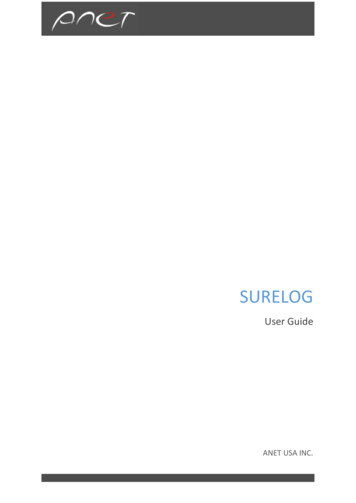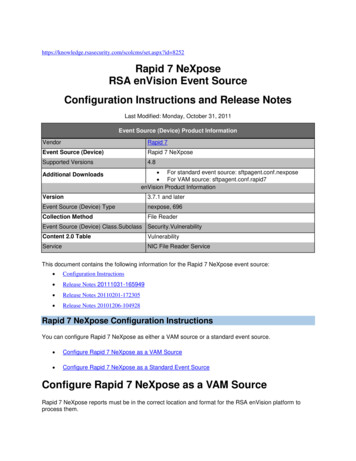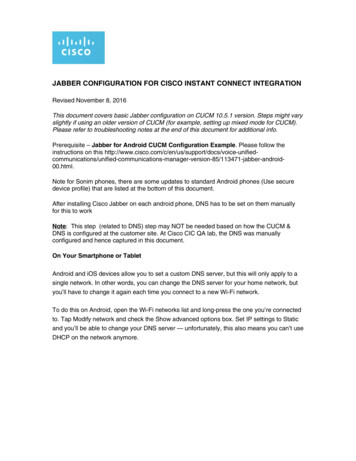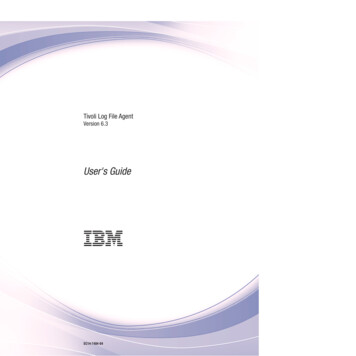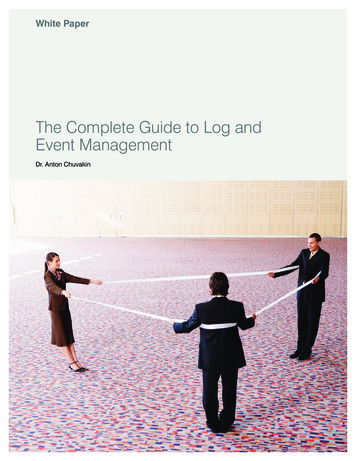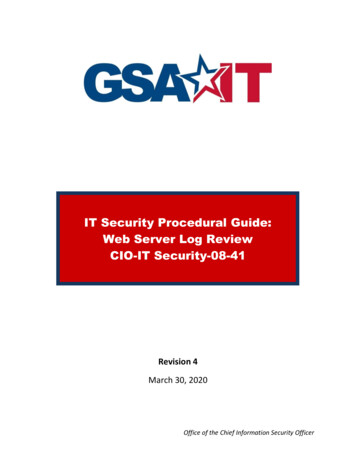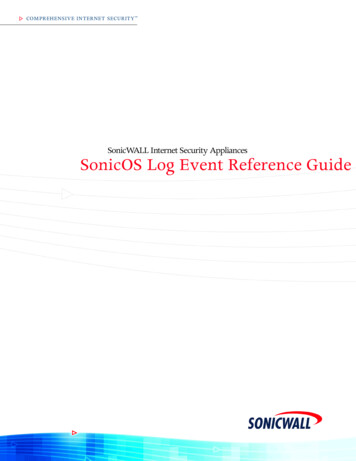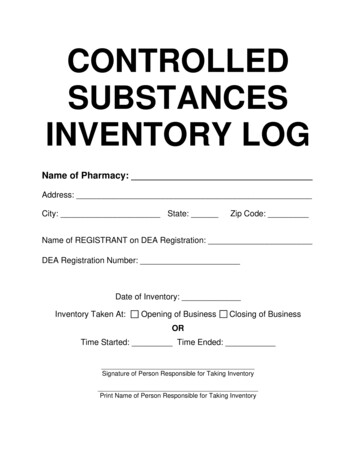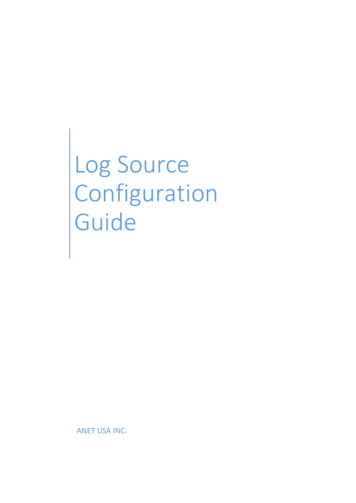
Transcription
Log SourceConfigurationGuideANET USA INC.
Configuring Log SourcesSureLog listens at the default ports for exported log files. The following is a list of firewallsand versions for which configuration instructions are included.Firewall NameVersion NumbersCheck PointLog import from most versions and LEA support for R54 andaboveNetScreenMost versionCisco SystemsMicrosoft ISACisco Pix Secure Firewall v 6.x, 7.x, Cisco ASA, CiscoIOS 3005, 1900, 2911, 3925, Cisco FWSM, Cisco VPNConcentrator, Cisco CSC-SSM Module 6.3.x,Cisco SSL WebVPN or SVC VPN, Cisco IronPort Proxy,Cisco Botnet module(Firewall, Web Proxy, Packet Filter, Server 2006 VPN)Server 2000 and 2004, W3C log format ThreatManagement Gateway (TMG)CyberGuardCyberGuard Firewall v4.1, 4.2, 4.3, 5.1CyberoamCyberoam Firewall Version: 9.5.4FortiNetFortiGate family, Webfilter, DLP, IPS modules, and IPSec, SSLVPN - v300A, v310B, FortiOS 5.x VPNWatchGuardAll Firebox Models v 5.x, 6,x, 7.x, 8.x, 10.x, 11, Firebox X series,x550e, x10e, x1000, x750eSnortMost versionsSecure ComputingSidewinderSidewinder G2, FIrewall Enterprise - Sidewinder (S4016)SonicWALLSOHO3, SOHO TZW, TELE3 SP/TELE3 Spi, PRO 230, 2040, 3060,4060, 5060, TZ 100/ TZ 100w, TZ 170, TZ 170 Wireless, TZ 170SP Wireless, TZ 200/ TZ 200w, TZ 210/ TZ 210w, NSA 240, NSA2400, NSA 2400MX, NSA 3500, NSA 4500, NSA 5000, NSAE5500, NSA E6500, NSA E7500, NSA E8500, NSA E8510,Management, Application control & SSL-VPN logs Juniper NetworksJuniper SRX seriesSRX100, SRX210, SRX220, SRX240, SRX650, SRX1400,SRX3400, SRX3600, SRX5600, SRX5800 NetScreen series
NetScreen most versions of Web Filter & Spam Modules IDP, SSL VPN series4500 & 6500, New Format Logs ISG series2000 6360, 8350 series3ComIPCop3Com X-family Version 3.0.0.2090 or laterStonesoftFirewall version 5.5Palo AltoPalo Alto Firewalls PA 5000 series, PANOS 4.1.0IPCop Firewall Version 1.4.17 / 1.4.18Configuring NetScreen FirewallSureLogsupports most versions of NetScreen Firewall Appliance (OS 3.x, 4.x, 5.x,.). Youcan either enable WELF or Syslog format.Enable Syslog Messages and Disable WebTrends Messages using the NetScreenAdministration Tools Console1.2.3.4.5.6.7.8.9.10.Log in to the NetScreen GUI.Click Configuration Report Settings Syslog in the left pane of the NetScreen GUI.Select the Enable Syslog Messages check box.Select the Trust Interface as Source IP for VPN and Include Traffic Log check box.Type the IP address of the SureLogserver and syslog port (514) in the Syslog Host Name /Port text box.All other fields will have default values.Click Apply to save the changes.Click Configuration Report Settings WebTrends in the left pane of the NetScreen GUIClear the Enable WebTrends Messages check box.Click Apply to save the changes.In certain versions of NetScreen firewall there is an option to record the completion11.of a transaction. Please select this option (if available) in the NetScreen firewall toenable SureLogto measure the sent and received bytes from the firewall traffic logs.Uncheck the TCP option. This will make the firewall to send syslogs in theconfigured UDP port.
If you would like to send NetScreen logs in WELF to SureLog, the you need to DisableSyslog Messages and Enable WebTrends Messages in the above steps. For more information,refer the NetScreen documentation.Configure/Enable Syslog Messages for Netscreen Firewall device using CLI Console:Execute the following commands to configure syslog via CLI:Syngress set syslog config 10.23.23.2 facilitates local0 local0Syngress set syslog config 10.23.23.2 port 514Syngress set syslog config 10.23.23.2 log allSyngress set syslog enableConfigure/Enable WebTrends for Netscreen Firewall device using CLI Console:Execute the following commands to configure WebTrends via CLI:Syngress set webtrends host-name 10.23.23.2Syngress set webtrends port 514Syngress set webtrends enableConfigure/Enable SNMP Protocol for Netscreen Firewall deviceUsing CLI Console:To add a new SNMP community: (Skip this step, if you have already defined a community)set snmp community " community name " Read-Only Trap-off version {any v1 v2c}To enable the SNMP Manager running in SureLogto make queries to SNMP Agent running inthe firewall:
set snmp host " community name " SureLogIP [src-interface interface through whichSureLogis connected ]Example: The following command example defines the IP address '10.5.1.24' as member ofthe SNMP community named 'olympia':set snmp host "olympia" 10.5.1.24 [src-interface inside]Enable SNMP manageability on the interface through which the SNMP manager inSureLogcommunicates with the SNMP agent in the NetScreen device.set interface interface name manage snmpUsing Web UI:To add a new SNMP community: (Skip this step, if you have already defined a community) Log in to the Netscreen web interfaceGo to Configuration Report Settings SNMP New CommunityEnter the following settings:ooooooo Community Name: community name Permissions:Write: (select)Trap: (clear)Including Traffic Alarms: (clear)Version: ANY (select)Hosts IP Address/Netmask and Trap Version: SureLogIP address Click Apply.To enable the SNMP Manager running in SureLogto make queries to SNMP Agent running inthe firewall: Go to Configuration Report Settings SNMPEdit community to add SNMP Manager IP SureLogIP address and the sourceinterface (interface through which SureLogconnects firewall) to that community.Under communities section, you will find the option to edit community. If SNMPAgent does not have a community, click 'New Community' button and providecommunity string, SNMP Manager IP address SureLogIP address and the sourceinterface (interface through which SureLogconnects firewall) to that community.Click Apply.Enable SNMP manageability on the interface through which the SNMP manager in SureLog,communicates with the SNMP agent in the NetScreen device.
Go to Network Interfaces Edit (for ethernet1)Enter the following settings:oo Service Options: no change Management Services: SNMPClick OK.Configuring Cisco Devices - PIX/ASA/FWSM/VPN ConcentratorSureLog supports the following versions of various Cisco devices.Cisco IOS Firewalls: 8xx18xx28xx38xx72xx73xx3005190029113925Cisco FWSM Catalyst Series: 65007600Cisco PIX versions: 6.x7.xCisco ASA: 5500 series9.1Cisco VPN Concentrators Series: 30003500Model FamilyModelCisco IOS SoftwareVersion
c871, c876,c877,c87812.4(4)Tc184112.3(14)Tc1811, c181212.4(4)Tc1801, c1802,c180312.4(4)T28xxc2801, c2851,c2821, c281112.3(14)T38xxc3845, O730112.3(14)T8xx18xxTo find out the version of your PIX firewall, Telnet to the PIX firewall and enter the showversion command.Cisco PIX does not create log files, but instead directs a log stream to the syslogserver, which writes the log information into a file. Make sure the syslog serveron SureLog can access the PIX firewall on the configured syslog port. For this,you may have to make a rule specific to this situation. Getting logs from Virtual Firewall (Virtual Domain)Configuring Cisco PIX using Command Line InterfaceConfiguring Cisco PIX from the User InterfaceConfiguring SNMP protocol for Cisco PIX using Command Line InterfaceConfiguring Cisco ASA using Command Line InterfaceConfiguring SSL WebVPN in Cisco ASA applianceConfiguring Cisco ASA NetFlow LogsConfiguring SNMP protocol for Cisco ASA using Command Line InterfaceConfiguring Cisco VPN 3000 ConcentratorConfiguring Cisco IOS SwitchConfiguring SNMP protocol for Cisco Firewalls using ASDM Web UI toolVirtual Firewall (Virtual Domain) logsPrerequisite for context/vdom in Cisco FirewallsThe Cisco Firewall IP address should be DNS resolvable from SureLog.There is no separate configuration required in SureLog for receiving logs from VirtualFirewalls of the Cisco physical device.
Configuration in Cisco device for Virtual FirewallIn order to support virtual firewalls for Cisco devices, you need to enable loggingbased on the context-name. Otherwise it is not possible for SureLog to detectVirtual Firewalls (vdom) of Cisco devices.Configuring Cisco PIX using Command Line Interface1. Telnet to the PIX firewall and enter the enable mode2. Type the following:configure terminallogging onlogging timestamplogging trap informationallogging device-id {context-name hostname ipaddress interface name string text}logging host interface name syslog ip [17/ syslog port ]where,interface nameis the interface on the PIX firewall whose logs need to be analyzed("inside" or "outside," for example).syslog ipis the IP address of the syslog server (i.e. SureLog), to which theFirewall should send the Syslogs.indicates that logs will be sent using the UDP protocol, to theconfigured syslog port on the syslog server. If left blank, the17/ syslog port syslogs are sent through the default syslog port (UDP port 514). Ifthe logs are sent through any other port, mention it as 17/ theUDP port number (For example: 17/1514).hostnamefirewall's host name (defined with the hostname configurationcommand). In this case, the hostname will appear in the logs sentfrom the Firewall.ipaddressinterface namethe IP address of a specific firewall interface namedinterface name ("inside" or "outside," for example). In thiscase, the IP Address of the Interface Name will appear in the logssent from the Firewall.string textan arbitrary text string (up to 16 characters). In this case, thearbitrary text string you have entered in string text will appearin the logs sent from the Firewall.context-namein PIX 7.x or FWSM 2.x operating in multiple-context mode, thename of the firewall context will appear in the logs sent from theFirewall.Example: logging host inside 11.23.4.56 17/1514
To verify your configuration, enter the show logging command after the last commandabove. This will list the current logging configuration on the PIX firewall.Configuring Cisco PIX from the User InterfaceLog in to the Cisco PIX user interface, and follow the steps below to configure the PIXfirewall:1. Enabling Logginga. Select Configure Settings Logging Logging Setupb. Select the Enable logging setup and Enable logging failover check boxesc. Click Apply.Changes are applied to the assigned PIX firewall configuration files when they aregenerated. The configuration files are then downloaded to PIX firewalls atdeployment.2. Configuring Syslog Servera. Select Configure Settings Logging Syslogb. Check Include Timestamp.c. Click Add to add a row.d. In the Add Syslog Server page that appears, enter the following:i.Interface Name - the firewall interface through which SureLog can bereached, the interface can be either inside or outside.ii.IP Address - the IP address of the syslog server to which logs have to be sentiii.Under Protocol, select the UDP radio buttoniv.The default UDP port is 514. If you have configured a different syslog listenerport on your syslog server, enter the same port here.e. Click Apply3. Configuring Logging Levela. Select Configure Settings Logging Otherb. Under Console Level List select Informational so that all report data is availablec. Click ApplyFor every transaction happening in Cisco PIX Firewall, an ACL configured in it matches.The matched ACL along with complete transaction detail is audited through Message-ID106100. Ensure that the logging is enabled for 'Message-ID 106100' in Cisco PIX Firewall.For more information about the message ID follow the below x/pix63/system/message/pixemsgs.html#wp1086617This message identifier contains the information about both accepted and deniedtransactions. The log information is parsed to get the 'Used' rules and is available in the'Firewall Rules Report Top Used Rules Report'.Configure/Enable SNMP Protocol for Cisco PIX Firewall device
Using CLI Console:To enable the SNMP Manager running in SureLog to make queries to SNMP Agent running in thefirewall:configure terminalsnmp-server host interface name hostname IP address of SureLog If you want to create a new SNMP community use the below command:configure terminalsnmp-server community community-string Example:configure terminalsnmp-server community publicConfiguring Cisco ASA Versions1. Telnet to the ASA firewall and enter the enable mode2. Type the following:configure terminallogging enablelogging timestamplogging trap informationallogging device-id {context-name hostname ipaddress interface name string text}logging host interface name syslog ip [udp/ syslog port ]3. If there are no URL Reports available in SureLog for CISCO ASA, enable HTTP inspection byexecuting the following command:inspect httpEnabling HTTP inspection will generate syslogs with ID 304001. This ID will be usedby SureLog to generate URL Reports.interface nameis the interface on the ASA Firewall whose logs need to beanalyzed (for example: "inside" or "outside").syslog ipis the IP address of the syslog server (i.e. SureLog), to which theFirewall should send the Syslogs.
udp/ syslog port indicates that logs will be sent using the UDP protocol, to theconfigured syslog port on the syslog server. If left blank, logs willbe sent to the default UDP port 514.hostnamefirewall's host name (defined with the hostname configurationcommand)ipaddressinterface namethe IP address of a specific firewall interface namedinterface name (for example: "inside" or "outside")string textan arbitrary text string (up to 16 characters)context-namein PIX 7.x or FWSM 2.x operating in multiple-context mode, thename of the firewall context can also be sent.For more information, refer the Cisco PIX documentation.Configuring Cisco ASA Versions using ASDMEnable LoggingCarry out the steps given below: Load the ASDMSelect Configuration Device Management Logging Logging SetupSelect Enable LoggingSelect Logging Logging FiltersChoose the syslog-servers as InformationalSelect Logging Logging Filters Syslog serversClick AddEnter the IP address and choose the appropriate interface and ensure that you choose UDPand enter the port numberSelect Logging Syslog SetupSelect 'Include time stamp in syslogs' option and scroll down to ensure the syslog ID's302013, 302014,302015,302016 are in enabled state and the logging level is set toInformationalDisable LoggingYou can disable specific syslog IDs based on your requirement.Note: By selecting the check mark for the Include timestamp in syslogs option, you can addthe date and time that they were generated as a field to the syslogs. Select the syslogs to disable and click Edit.From the Edit Syslog ID Settings window, select the Disable messages option and click OK.The disabled syslogs can be viewed in a separate tab by selecting Disabled syslog IDs fromthe Syslog ID Setup drop-down menu.
For more information, refer the Cisco PIX documentation.Configuration for SSL WebVPN in Cisco ASA applianceSureLog requires syslog message IDs 722030 and 722031, which by default is at debug level,to process Cisco SVC VPN logs. Set the information level to these syslog IDs by executingbelow commands in global configuration mode:hostname(config)# logging message 722030level 6hostname(config)# logging message 722031level 6You can confirm by executing the below command:hostname(config)# show logging message722030Configuring Cisco ASA NetFlow Logs and Disabling NetFlow on Cisco ASA/ADM using commandline and ASDMSureLog support NetFlow version 9 packets, which is introduced in Cisco ASA 8.2.1/ASDM6.2.1.Configuring ASA device using console mode to send NetFlow version 9 packets to SureLogis given below: As SureLog is capable of receiving either Syslog or NetFlow packet from an ASA box, disableSyslog and enable NetFlow.To disable Syslog and enable NetFlow execute the following commands:(config)# flow-export destination inside SureLog Server IP 1514(config)# flow-export template timeout-rate 1(config)# flow-export delay flow-create 60(config)# logging flow-export-syslogs disable --- This command will disable logging syslogmessages(config)# access-list netflow-export extended permit ip any any(config)# class-map netflow-export-class(config-cmap)#match access-list netflow-exportAssociate global policy map with netflow class map Option 1If you have a global policy map, associate the above netflow class-map netflow-export-classto the global policy.For example: if your global policy map is named global policy asa, you need to execute thebelow commands:
(config)# policy-map global policy asa(config-pmap)# class netflow-export-class(config-pmap-c)# flow-export event-type any destination SureLog Server IP if the above command fails use the below:(config-pmap-c)# flow-export event-type all destination SureLog Server IP Option 2If you wish to create a new policy map named netflow-export-policy and make this as yourglobal policy follow the below steps:(config)# policy-map netflow-export-policy(config-pmap)# class netflow-export-class(config-pmap-c)# flow-export event-type any destination SureLog Server IP if the above command fails use the one below:(config-pmap-c)# flow-export event-type all destination SureLog Server IP Make policy map netflow-export-policy as your global policy:(config)# service-policy netflow-export-policy globalFor UI mode configuration using ASDM access, refer the Cisco forum 4To disable NetFlow on Cisco ASA/ADM execute the following commands:(config)# flow-export disable(config)# no flow-export destination inside SureLog Server IP 1514To disable NetFlow on Cisco ASA/ADM using ASDM Click on Configuration FirewallClick on Service Policy Rules. Look for the policy indicating netflow exportCheck the IP address if the flow is pointing to the machine where you want to forward syslog.If so, delete it and write the configuration in to memory (Save it).Configure/Enable SNMP Protocol for Cisco ASA Firewall deviceUsing CLI Console:To enable the SNMP Manager running in SureLog to make queries to SNMP Agent running in thefirewall:
configure terminalsnmp-server enablesnmp-server host interface name hostname IP address of SureLog [poll]Example:configure terminalsnmp-server enablesnmp-server host inside 192.168.101.155 pollIf you want to create a new SNMP community use the below command:configure terminalsnmp-server community community-string Example:configure terminalsnmp-server community publicConfiguring Cisco VPN 3000 ConcentratorCurrently we support Cisco IOS Compatible Log Format and Original Log Format forCisco VPN Concentrator.Importing of already saved Cisco VPN Concentrator logs is not supported because those logsare saved in either of the following formats which is not supported in SureLog: Multi lineTab DelimitedComma DelimitedFollow the below steps to configure the VPN Concentrator:1. Configuring Syslog Servera. Login to the Cisco VPN 3000 Concentrator Management console.b. Go to Configuration System Events Syslog Serversc. Click the Add buttond. In the Syslog Server text box enter the IP Address of the machine where SureLog isrunning.e. Enter the Port value. The default syslog server port for SureLog is 514.f. Facility is Local 72. Configuring Syslog Eventsa. Go to Configuration System Events Generalb. For Syslog Format you can either select Original or Cisco IOS Compatible format.c. For Events to Syslog select Severities 1-5d. All other configurations are default for this page.e. Click Apply button
For more information, refer the Cisco VPN Concentrator documentation.Configuring Cisco IOS SwitchFollow the below steps to configure the Cisco IOS Switch:1. Login to the Cisco IOS console or Telnet to the device.2. Change the configuration mode of the device.Use the following command:configure terminal3. Enable logging by using the following commands:logging onlogging trap informationallogging IP Address 4. If there is a Firewall module in the IOS device, use the following command to enabl
IOS 3005, 1900, 2911, 3925, Cisco FWSM, Cisco VPN Concentrator, Cisco CSC -SSM Module 6.3.x, Cisco SSL WebVPN or SVC VPN, Cisco IronPort Proxy, Cisco Botnet module Microsoft ISA (Firewall, Web Proxy, Packet Filter, Server 2006 VPN) Server 2000
